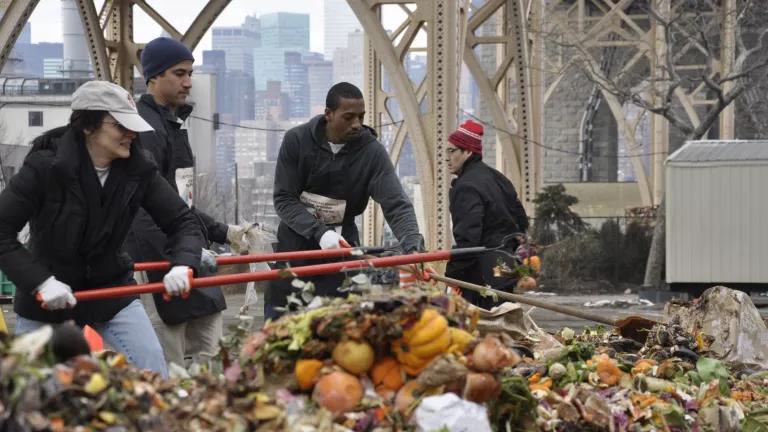Recycling Infrastructure Grants Must Include Food Scraps
With funding provided through the Infrastructure Investment and Jobs Act of 2021, the EPA is developing a pair of grant programs that have the potential to significantly improve progress towards our nation's goal to reduce food waste by 50 percent by 2030.
Update as of November 2022: EPA released grant program guidelines which included our recommendations. More information can be found on EPA's Solid Waste Infrastructure for Recycling Grant Program and Recycling Education and Outreach Grant Program websites.
With funding provided through the Infrastructure Investment and Jobs Act of 2021, EPA is developing a pair of grant programs that have the potential to significantly improve progress towards our nation's goal to reduce food waste by 50 percent by 2030. The first program focuses on improving the effectiveness of residential and community recycling programs through public education and outreach while the second grant program covers solid waste infrastructure for recycling.
The agency has engaged in several listening sessions and is requesting information from stakeholders as to local needs, best practices, and models to consider in their development of the programs. NRDC sees four elements as an important part of the grant program’s effectiveness.
I. Recycling Infrastructure Grant Programs Must Include Food Scraps and Other Organic Material
Food is the largest component of landfills nationwide – contributing over 36 million tons to landfills each year and accounting for 24% of landfilled municipal solid waste. In order to reach zero waste and climate goals at the municipal, state, and federal levels, food scraps (along with other organics) need to be managed separately from the other materials in the municipal solid waste stream. Even with the best efforts to prevent food from becoming waste, there will always be inedible parts of food that need to be recycled. Recycling food scraps has the potential to divert 20.9 million tons of material from landfills and prevent 4.94M metric tons CO2e of climate pollution from entering the atmosphere per year, as well as produce a net financial benefit of $239.7 million annually. Currently, there are over 5,000 composting facilities nationwide, yet only around 500 facilities accept food scraps. Investments are needed to support current composting operations to accept and process food scraps, as well as build new facilities at all scales and add or expand organics collection. Any federal grant programs to support recycling infrastructure should include organics recycling, and explicitly include food scraps as an eligible material.
Preventing and recycling organic waste, including food scraps, also helps mitigate the significant environmental justice considerations associated with landfills and incinerators. Nearly 80% of incinerators in the U.S. are located in chronically under-resourced communities, where the majority of residents are Black, Indigenous, or other people of color, leading to environmental degradation, negative health effects, and other burdens. In order to address longtime inequities, communities of color that have suffered from environmental justice impacts should be prioritized in funding provided to support food scrap collection, recycling, and other materials management efforts. At the same time, while composting infrastructure has fewer harmful environmental impacts than landfills or incinerators, waste management facilities (including organics recycling facilities), should not be disproportionately located in communities of color. To prevent this, one of the grant requirements should be the development of a siting plan that incorporates significant community participation. The plan should include an assessment of the potential burdens upon the surrounding community and corresponding actions to address them.
II. Grant Programs Must Fund Assessments, Planning Efforts, and Policies
Adequate planning is the first step to a successful infrastructure project, one that will work long- term for the communities it is serving, whether through an assessment, planning, or another mechanism. Through NRDC’s Food Matters work, we supported the cities of Denver and Baltimore to conduct food scrap recycling assessments and saw the importance of these feasibility studies to determine what composting infrastructure will best serve the community. The assessments have informed the cities’ work plans and helped prioritize future actions. For example, based on the assessment, the City of Denver is exploring how to get more composting infrastructure and recently passed a new law making recycling and composting collection free but setting up monthly fees for collections of trash headed to the landfill. Any grant funding should include support for assessments and other planning efforts in addition to facility upgrades and new development of processing facilities or collection infrastructure.
Additionally, state and local policies such as organic waste bans, waste diversion requirements, landfill taxes, pay-as-you-throw policies, and efficient permitting have been proven to boost food scrap recycling, in addition to expanding food rescue and creating new jobs. Recycling infrastructure is essential to support implementation of these policies, but the planning and assessment processes that need to be carried in order to implement these policies effectively are costly. In addition to facility planning efforts, this grant program should make funds available to states, and local and tribal governments to plan or implement proven policies that reduce food waste in landfills and incinerators through organics recycling and waste prevention.
III. Grant Funding Must Support Infrastructure at Various Scales
Not all organics recycling infrastructure needs to be concentrated at industrial scale; some communities may be better served by locally-led community-scale compost processing at sites such as, urban gardens, schools, farmers’ markets, and other regional food centers. Additionally, keeping food scrap collection and processing locally and on smaller scales can limit the potential negative environmental impacts, like greenhouse gas emissions related to transporting scraps. Grant funding should be made available to small-scale collectors and processors for purchasing of land, materials, labor, transportation, and other operational requirements.
The awarding of grant funding should also take into account if the management method (composting or anaerobic digestion) will use the materials with respect to their highest and best ecological use. Anaerobic digestion (AD) may not always be the best technology for processing a particular organic waste stream, depending on whether or not the feedstock has been source separated and how the final products (digestate) are treated. The choice of AD versus composting or other options should take into account whether nutrients will be preserved or lost (for instance, if digestate from AD is landfilled after energy extraction, then nutrients are lost), and how to maximize the potential for organic materials to contribute to soil health through being processed as soil amendment.
IV. Grant Funding Should Also Support Waste Prevention and Outreach and Educational Materials
Education is critical to the success of recycling operations. The best-planned projects can go under-utilized if the community does not know about them and projects can be unsuccessful if the community does not know how to participate properly. For example, plastic contamination in food scrap streams continues to be an issue for processors, often resulting from residents and businesses putting the wrong materials in compost collection. Community education is essential to ensure that residents participate appropriately and thus, materials can be managed properly.
Education and outreach should also prioritize waste prevention. The greatest environmental, economic, and social benefits of food waste reduction are associated with reducing or preventing food from becoming waste, which is reflected in EPA’s food waste management hierarchy highlighting the need for source reduction above all other management strategies. Food waste prevention and recycling education and outreach materials can draw from numerous existing resources. For example, the National Academies of Sciences, Engineering and Medicine 2020 report A National Strategy to Reduce Food Waste at the Consumer Level makes several recommendations which are relevant to EPA’s grant program. This grant program should make funding available for education and outreach projects, and if that is beyond the scope of this grant, all grant submissions should be required to include an education and outreach plan that includes prevention.
In closing, NRDC sees a great opportunity to address interconnected climate and environmental justice issues through better management of food scraps in the Solid Waste Infrastructure for Recycling Program. Through this critical funding, EPA can ensure that across the country food waste is better prevented and that more food scraps are recycled into nutrient-rich soil amendment rather than generating greenhouse gasses and other harmful pollutants when landfilled or incinerated. Increasing our capacity to properly manage food scraps is critical to achieving zero waste and climate goals, such as our national goal to reduce food waste by 50% by 2050, as well as providing other environmental, economic, and social benefits.





